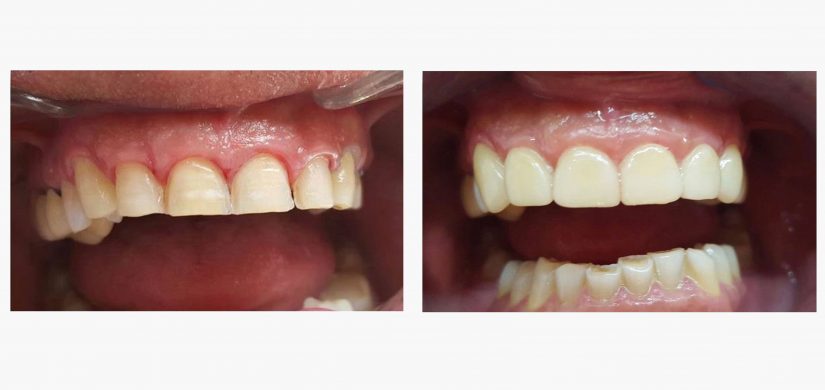The milled crowns can be made with a wide range of materials according to the specification of the cases to be restored, including the possibility of making ceramic metal crowns presinterized in CoCr in addition to milled metal.
The realization of any of these can be either by design from files sent by the clinic, or by scanning the work models in the laboratory. Being its process elaborated by digitalization.
Material types
Lithium disilicate
Of great aesthetic and functional result, both the Lithium Disilicate and the Lithium Silicate reinforced with Zirconium are ideal solutions for previous areas where there may be an intermediate piece, thus giving an option of much aesthetics with functional solution in many cases .
Advantages: Degree of optimum transparency for complete crowns. Integration and mimicry.
Aesthetic monolithic zirconium
Using materials such as Cercon XT or Zirlux stratified with a hardness of 750 mp. and stratification similar to the natural tooth as well, such as conventional monolithic zirconium with a hardness of 1,200 mp., good abrasion, conventional cementation, and absolute biocompatibility. We can access restorations with guarantee, safety and aesthetic commitment.
Indicaciones: Cercon XT o Zirlux estratificado para grupos anteriores con puentes. Zirconio monolítico convencional para todo tipo de tramos y puentes en boca de hasta dos intermedias.
Advantages: Biocompatible, aesthetic material, requires little thickness because it is monolithic.
Milled feldspathic ceramics
Ideal for unitary pieces, with excellent aesthetic results in previous groups.
Indications: For aesthetics and characteristics only recommended for anterior teeth.
Advantages: Great luminosity, naturalness and biocompatibility.
Composites with ceramic structure
Abrasion as in natural teeth, excellent indication for loading on implants and immediate loads.
Advantages: Abrasion similar to natural tooth. Possibility of very fine finishes.
PMMA milled crowns
With a homogeneous composition of the material that makes them ideal as temporary teeth of long duration. These temporary restorations are very useful for complex cases that require more planning time. Also ideal for type B.O.P.T restorations.
Advantages: Great stability of the material and possibility of making temporary material of long duration. Due to its CAD design it allows exact realization to the definitive prosthesis.
The milled veneers, being also made by digital technology, adhere to the surface of the tooth thus allowing to keep most of the natural tooth.
This type of work is usually done with feldspathic ceramics supplied in blocks with chromatic stratification that allow working with minimum thickness, thus achieving a result with a very natural appearance.
Material types
Feldespathic pottery
Optimal for restorations of anterior teeth, including those with altered position, or to mask stains. With excellent aesthetic results.
Advantages: Great luminosity, naturalness and biocompatibility.
Indications: For aesthetics and characteristics only recommended for anterior teeth.
Leucite pottery
With properties that give it a good luminosity and a natural transition of color from the dentin to the incisal edge, this material offers very natural looking results.
Advantages: Excellent adhesive bond thanks to the characteristics of engraving, and naturalness.
This type of treatment is applied to teeth that have suffered a fracture or a moderate level of caries.
Both in the case of Inlay (which does not include any dental cusp) and Onlay (which covers a functional cusp), we work with feldspathic ceramics of high translucency (HT) and composites whose ceramic component gives them excellent properties in the mouth of their patients .
As with the other restorations, this would be done by scanning the work models if the clinic did not send digital files.
Material types
Feldespathic pottery
With greater personalization options for the type of material, the feldspathic incrustations have an optimal engraving system and remain unchanged over time.
Advantages: Good adhesion, naturalness and biocompatibility.
Lithium disilicate
Similar to feldspathic ceramic inlays but with greater hardness to abrasion.
Advantages: Good adhesion, optimal if the antagonist is strong.
Composite
With a hardness similar to the natural tooth, the composite inlays allow for the characteristics of this material to leave the finishes very thin.
Advantages: Optimal if the antagonist is weak, it can be added directly in clinic.


With respect to other types of crowns, the ceramic metals stand out for their greater degree of resistance.
We currently carry out this type of work with digital technology in the realization of its structures, designing in milled structures of sintered CoCr, which gives them a perfect homogeneity of material, superior stability to cast systems, and uniform thicknesses and controlled by the design in CAD software.
Indications: Treatments in which structural rigidity is required.
Advantages: Great accuracy and adjustment for milled processing. Metal without tension and homogeneous surface.
Prótesis fija atornillada sobre implantes
System that fixes the prosthesis to the abutment through a mechanized connection.
The screwed metal structures can be milled or sintered, having direct connection to implants for ceramics or composites.
The screwed cement crowns added to the structures would be to choose between the following materials: Zirconium, Composite, Disilicate, Feldspar, PEEK, or Ceramic Metal.
Advantages: It can be disassembled and assembled easily in the clinic, and more hygienic by not leaving traces of cement.


For all this we have an extensive library of implants with which to solve the maximum number of cases.
Advantages: Good adjustment capacity, biocompatibility and aesthetic results.

Prótesis fija cementada sobre implantes
System that connects the abutment to the prosthesis using cementing techniques. By designing the milled pillars using our CAD CAM systems, we have achieved that these have a perfect adaptation to gums and emergency profiles.


On the custom milled abutments that we use, subsequently milled crowns are cemented, having as materials to choose: Zirconium, Composite, Disilicate, Feldspar, or Ceramic Metal.
Advantages: The implant insertion axis can be corrected when milling the structure. The crowns have more stability because they do not have an insertion hole.



































